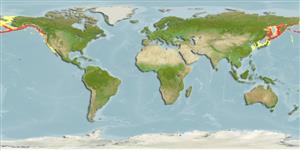分類 / Names
俗名 | 同種異名 | Catalog of Fishes(屬, 種) | ITIS | CoL | WoRMS | Cloffa
Elasmobranchii
板鰓亞綱 (鯊魚與魟魚) (sharks and rays) >
Squaliformes (Sleeper and dogfish sharks) >
Somniosidae (Sleeper sharks)
Etymology: Somniosus: Latin for sleepy, reflecting Lesueur’s surmise that these sharks are slow or sluggish because of their relatively small fins (hence the name sleeper sharks). (See ETYFish); pacificus: -icus (L.), belonging to: the Pacific Ocean (specifically, the North Pacific), where it occurs (also in Arctic Ocean). (See ETYFish).
Environment: milieu / climate zone / depth range / distribution range
生態學
海洋 底中水層性; 深度上下限 0 - 2205 m (Ref. 119696). 溫帶; 72°N - 23°N, 121°E - 110°W
North Pacific and Arctic: Taiwan to Japan and Kuril Islands, Sea of Okhotsk, southeastern Kamchatka, Commander and Aleutian Islands, and southern Baja California to Gulf of Alaska, Bering Sea, Chukchi Sea and Beaufort Sea.
北太平洋: 日本而且沿著西伯利亞岸邊到白令海,南加州 (美國) 與墨西哥的下加利福尼亞。 偶發的記錄來自南太平洋 (大南半球 Somniosus 到北太平洋 Somniosus pacificus 的任務是試驗性的).(參考文獻 31367) 在大洋洲水域,它生存於塔斯梅尼亞南方的海底山脈,挑戰者高地 (外海的紐西蘭東部) 與可能地從 Macquarie 島.(參考文獻 6871) 西南大西洋: 外海的烏拉圭 (參考文獻 35864) 巴西 (參考文獻 53443) 與阿根廷.(參考文獻 58839)
大小 / 重量 / 年齡
Maturity: Lm ? range ? - ? cm
Max length : 440 cm TL 雄魚/尚未辨別雌雄; (Ref. 247); 430.0 cm TL (female)
背棘 (總數): 0; 臀棘 0; 臀鰭軟條: 0. Diagnosis: Somniosus pacificus differs from S. antarcticus by the following characters: interdorsal space about 70% of prebranchial length (vs. 80%); height of first dorsal fin about 3.7% of precaudal length (PCL) (vs. 3.0%); height of second dorsal fin about 3.4% of PCL (vs. 2.9%); number of turns in spiral valve 32-37 (mode 33) (vs. 36-41, mode 39); precaudal vertebrae 28-30 (mode 29) (vs. 30-31, mode 30) (Ref. 50224).
均勻略灰色-用藍黑色的鰭粉紅色; 活體可能有白色的斑點在背面上.(參考文獻 6871) 短圓的吻又極圓柱狀的身體與小的尾前椎鰭,大小相同的背鰭, 不對稱的尾鰭有一個發展良好的腹面葉 (參考文獻 6871), 第一背鰭背面更靠近腹鰭超過胸鰭,間背片的間隙少於從吻尖到第一個鰓裂的距離, 沒有短的龍骨脊在尾鰭基底上, 上顎齒矛尖形的, 下顎齒有短的, 低又極傾斜尖頭與高的狹窄根.(參考文獻 247)
Demersal and mesobenthopelagic (Ref. 119696); found on continental shelves and slopes (Ref. 247). At high latitudes, occasionally occurs in littoral and even intertidal areas; in lower latitudes it may never come to the surface and ranges down to at least 2,000 m (Ref. 247), reported to about 2,205 m in the Hawaiian Is. as recorded by camera arrays (Ref. 119696). Feeds on bottom animals such as fishes, octopi, squids, crabs and tritons; also harbor seals and carrion (Ref. 247). Ovoviviparous (Ref. 205), with 300 pups in a litter (Ref. 247), length at birth about 42 cm or less (Ref. 26346). The flesh contains a type of toxin which, when eaten, produces symptoms of drunkenness (Ref. 583). Possibly reaches lengths greater than 700 cm (Ref. 247). It is of limited importance in fisheries, with older small-scale commercial harvests reported in southern areas; and based on its population dynamics it can be sensitive to overfishing (Ref. 117245).
棲息於大陸棚與斜坡了。 (參考文獻 247) 在高的緯度,它出現於沿海地區中甚至潮間帶的區域; 在低的緯度它可能從未中來到了表面,而且範圍向下至至少 2,000 公尺。 (參考文獻 247) 吃底部動物例如魚,章魚,烏賊,螃蟹與齒突; 也港區的海豹與腐肉.(參考文獻 247) 卵胎生的 (參考文獻 205), 藉由 300個幼胎一胎 (參考文獻 247), 長度出生時大約 42 公分以內.(參考文獻 26346) 肉包含一個毒素的類型, 當吃, 生產酒醉的癥狀.(參考文獻 583) 可能地達到長度大於 700 公分。 (參考文獻 247)
Life cycle and mating behavior
成熟度 | 繁殖 | 產卵場 | 卵 | 孕卵數 | 仔魚
Probably ovoviviparous (Ref. 247). Size at birth 42 cm or less (Ref. 26346). Distinct pairing with embrace (Ref. 205).北太平洋: 日本而且沿著西伯利亞岸邊到白令海,南加州 (美國) 與墨西哥的下加利福尼亞。 偶發的記錄來自南太平洋 (大南半球 Somniosus 到北太平洋 Somniosus pacificus 的任務是試驗性的).(參考文獻 31367) 在大洋洲水域,它生存於塔斯梅尼亞南方的海底山脈,挑戰者高地 (外海的紐西蘭東部) 與可能地從 Macquarie 島.(參考文獻 6871) 西南大西洋: 外海的烏拉圭 (參考文獻 35864) 巴西 (參考文獻 53443) 與阿根廷.(參考文獻 58839)
Yano, K., J.D. Stevens and L.J.V. Compagno, 2004. A review of the systematics of the sleeper shark genus Somniosus with redescriptions of Somniosus (Somniosus) antarcticus and Somniosus (Rhinoscymnus) longus (Squaliformes: Somniosidae). Ichthyol. Res. 51:360-373. (Ref. 50224)
IUCN 瀕危狀態 (Ref. 130435)
近危 (NT) (A2bd); Date assessed: 29 August 2019
人類使用
漁業: 沒有興趣
更多資訊
參考文獻養殖養殖資訊品種遺傳學Electrophoreses遺傳率疾病加工NutrientsMass conversion
合作者照片Stamps, Coins Misc.聲音神經毒速度泳型鰓區Otoliths腦重體重比眼睛色素
工具
特別的報告
下載 XML
網路資源
Estimates based on models
Preferred temperature (Ref.
123201): 0.5 - 4.5, mean 2.3 °C (based on 400 cells).
Phylogenetic diversity index (Ref.
82804): PD
50 = 0.5313 [Uniqueness, from 0.5 = low to 2.0 = high].
Bayesian length-weight: a=0.00575 (0.00316 - 0.01049), b=3.09 (2.93 - 3.25), in cm total length, based on LWR estimates for this species & (Sub)family-body (Ref.
93245).
營養階層 (Ref.
69278): 4.4 ±0.4 se; based on diet studies.
回復力 (Ref.
120179): 低的, 最小族群倍增時間4.5 - 14 年 (Fec=300; assuming tm<=10).
Fishing Vulnerability (Ref.
59153): Very high vulnerability (90 of 100).
Climate Vulnerability (Ref.
125649): Moderate vulnerability (38 of 100).
